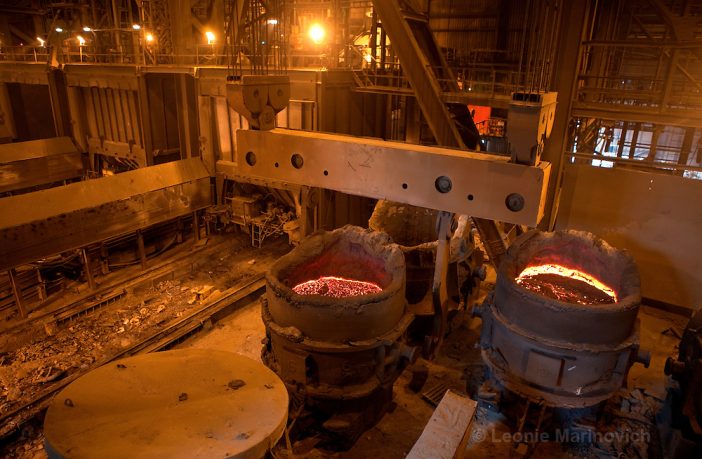- Communities in the Vaal have suffered the effects of pollution from AMSA’s Vanderbijlpark plant for many decades.
- The people in the Vaal are dying
- Animals are dying and a few years from now, this land will not be able to be used by anyone for anything
Local environmental justice group the Vaal Environmental Justice Alliance (VEJA), together with local communities from Sebokeng, Boipatong, Boiphelong and Sharpeville, protested outside ArcelorMittal South Africa’s headquarters in Vanderbijlpark yesterday morning as shareholders made their way to AMSA’s Annual General Meeting (AGM).
Armed with signs saying “Stand with Us Against Big Polluters”, “AMSA Must Comply with MES”, and “Prevent Pollution, Protect Nature”, community members made clear their demands of the shareholders and executives of ArcelorMittal South Africa (AMSA).
Longstanding Vaal activist and coordinator of VEJA, Samson Mokoena, said that: “The shareholders should know their profits are made at huge cost to the environment and the people living in the Vaal, who suffer from various respiratory diseases and other serious health conditions. Although AMSA is giving jobs to some people, the people in the Vaal are dying, animals are dying and a few years from now, this land will not be able to be used by anyone for anything, and the shareholders would have spent the money they have made from people’s suffering. Companies in South Africa are supposed to pay for the pollution that they cause and make sure they clean up their mess, but they don’t, and the government doesn’t care. We are here today to say: enough is enough.”
As Africa’s largest steel operation, the profits made by the company, as well as the remuneration of executives are among the issues discussed at AMSA’s AGM. Yet the environmental impacts of its Vanderbijlpark operations and the effects of pollution on local communities did not appear on their AGM agenda; neither did plans to address soil and water contamination, to reduce its polluting air and greenhouse gas (GHG) emissions, or even address the risks climate change poses to AMSA’s own operations.
This is despite AMSA being one of the top 10 GHG emitters in South Africa, emitting more CO2 per year than the entire population of the City of Cape Town, and facing a criminal prosecution for violation of its air emission licence. AMSA’s Vanderbijlpark Works is situated in the Vaal Triangle Airshed Priority Area, so declared because of the dangerously high levels of air pollution.
Whereas parts of the country have been ravaged by drought, AMSA uses roughly the equivalent of 39 200 Olympic-sized swimming pools of water annually. AMSA has also caused groundwater pollution, with tar remnants infiltrating ground water, with one site having an approximately 3m thick coal tar pool.
While community members made their demands known outside the AGM, attorneys from the Centre for Environmental Rights (CER) and representatives of VEJA, who had registered as shareholders of AMSA, were inside the AGM. CER and VEJA asked AMSA’s Chairman of the Board Mpho Makwana and Chief Executive Officer Kobus Verster for AMSA’s detailed plans on reducing GHG emissions, rehabilitating and remediating areas affected by pollution, and implementing the recommendations of its own Environmental Master Plan.
AMSA refused to release its “Environmental Master Plan”, developed after government intervention in the early 2000s, to affected communities until 2014, when the Supreme Court of Appeal ordered AMSA to release the Plan to VEJA.
When asked by CER attorney Leanne Govindsamy asked whether AMSA was misleading shareholders by failing to adequately report on climate related financial risks in its annual report, AMSA declined to answer directly, instead saying that the company belongs to the World Business Council for Sustainable Development in terms of which they report on their carbon footprint.
When asked whether AMSA had a concrete plan to reduce emissions, including emission targets, AMSA responded that they did not have climate change targets, because the technological developments to reduce emissions in the steel industry had not advanced to a point of allowing major reductions. However, in the steel sector, Indian manufacturer Mahindra Sanyo Special Steel has committed to reduce their emissions by up to 35% by 2030.
When asked whether they have a detailed plan to address the harm caused by their pollution in the Vaal, AMSA responded that the Environmental Master Plan, originally compiled in 2003, was now outdated and that they were working on a “strategy” to address such harm. The Master Plan remains largely unimplemented.
In August 2018, Environmental Management Inspectors in the Gauteng Department of Agriculture and Rural Development issued a compliance notice to AMSA in relation to their air pollution, and there is also a criminal prosecution pending for violation of AMSA’s air emission licence, reported in AMSA’s most recent Integrated Report. In November 2018, DEA also issued a remediation order to AMSA for contaminated land on its premises.
However, the company remains in non-compliance with environmental laws, and the CER has written to authorities, on behalf of VEJA, demanding enforcement action, most recently in September 2018, failing which VEJA can approach the High Court directly (download this correspondence below).
Download: Fact Sheet on ArcelorMittal South Africa
Author: Bryan Groenendaal















